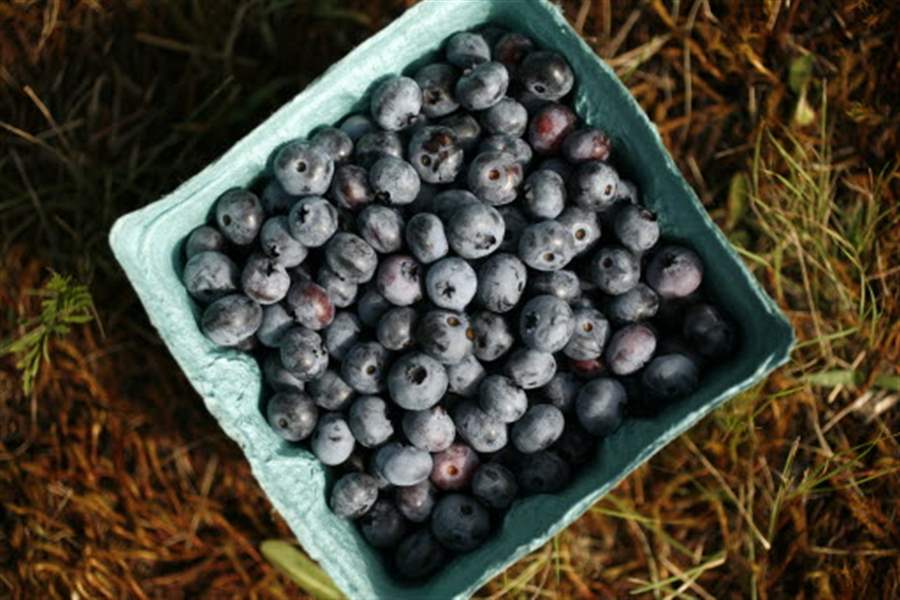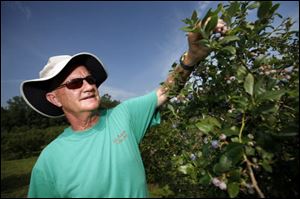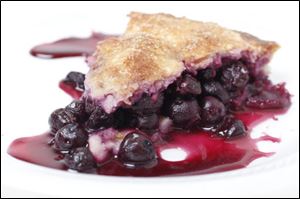
The beauty of blueberries
7/26/2011

Steve Elzinga checks out the blueberries at Erie Orchards.
Steve Elzinga has a secret way to make his blueberry bushes so productive.
It's doing nothing.
As co-owner and president of Erie Orchards and Cider Mill in Erie, Mr. Elzinga oversees some 1,800 blueberry bushes. His orchard's peach and apple trees require constant care and maintenance, but the blueberry bushes? No fertilizing. No spraying. Not even irrigation.
It's a hardy fruit, and reliable. But Mr. Elzinga benefits particularly from an accident of place. One part of his orchard used to be filled with oak trees. Over the years, their fallen leaves left an acid residue in the ground -- just the right amount of acid, as it turns out, to grow blueberries, which thrive in acidic earth. It is this happy circumstance that has kept him from ever having to treat the ground.
And that works out well for his customers. Erie Orchards is what is known as a U-pick farm, where customers come and pick their own blueberries in July, peaches in August, and apples and pumpkins in the fall. The seasons overlap, but customers tend to get in their minds that once the peaches come in, all they want to pick are peaches, and once the apples start appearing, it's apples from then on, he said.
Of course, those who want the bounty of the harvest but don't want to do the work can buy blueberries at the orchard's expansive store, which also stocks jams, mustards, fresh doughnuts, and cider slush to ward off the summer's heat.
Last year was especially productive for blueberries, he said. The bushes were full until mid-August. This year's crop is a little lighter, but the payoff is that the berries are sweet and delicious.
"The biggest factor for us this year was the lack of pollination. It was cool and rainy in April and May," he said, adding that the temperature has to be about 65 degrees for bees to want to pollinate flowers.
The orchard contracts with a local beekeeper to keep bees on hand, and those bees make the honey that is sold in the orchard store.
After the cool, wet spring, this summer has been hot and dry -- and that makes for better berries, he said.
"The sunshine is the key. That's the sweetness. We've had tremendous sunshine this year, and heat," Mr. Elzinga said.
These days, the orchard does much of its business through entertainment activities, from hayrides and pony rides to concerts and magic shows. But according to Mr. Elzinga, picking one's own fruit is also a form of entertainment. Young families often come in with their children, he said, and make an outing out of gathering fruit for their tables.
Apples make up the largest share of the orchard's U-pick business, but about 2 1/2 acres are set aside for blueberries. Most of that area is fenced in and covered by nets to keep out the birds; it turns out that humans are not the only creatures that like blueberries. Mr. Elzinga keeps the rest of the bushes uncovered, in part because the netting is expensive and time-consuming to erect. But mostly, he said, "I leave a little bit outside [the netting] so the birds don't get frenzied. They'll find a way in."

Blueberry pie.
Mr. Elzinga does not want personally to grow blueberries in Kenya ("I don't want to be the king of blueberries," he laughed. "I'm already that"). But he does think they might make a good cash crop for some of the local farmers there. Blueberries are not native to Africa, but Kenya has a large population of Europeans and Americans, especially in the capital of Nairobi, and they might welcome a favorite fruit that is not available for thousands of miles. So he has begun to offer his expertise to Kenyans to show them how to grow blueberries.
Inside the door to the Erie Orchards store is a photograph of him helping a Kenyan farmer plant a blueberry bush.
Contact Daniel Neman at: dneman@theblade.com or 419-724-6155.
RECIPES
Blueberry Pancakes
1 cup all-purpose flour
1 teaspoon baking powder
¼ teaspoon baking soda
¼ teaspoon salt
2 tablespoons granulated white sugar
1 large egg, lightly beaten
1 cup buttermilk
3 tablespoons unsalted butter, melted and cooled
Fresh or unthawed frozen blueberries
Melted butter or oil for greasing the pan.
In a large bowl whisk together the flour, baking powder, baking soda, salt, and sugar. In a separate bowl whisk together the egg, buttermilk, and melted butter. Make a well in the center of the dry ingredients and then pour in the egg mixture, all at once, and stir (with a rubber spatula or wooden spoon) just until combined. The batter should have some small lumps. (Do not overmix the batter or the pancakes will be tough.) This pancake batter can be covered and stored in the refrigerator for up to 24 hours.
Heat a frying pan or griddle over medium high heat until a few sprinkles of water dropped on the pan or griddle sizzle. Adjust the temperature as needed. Can also use an electric griddle with the temperature set at 350e_SDgr. Using a piece of paper towel or a pastry brush, lightly brush the pan with melted butter or oil (or spray with a non stick vegetable spray.)
Using a small ladle or scoop, pour about ¼ cup of pancake batter onto the hot pan, spacing the pancakes a few inches apart. Evenly sprinkle the uncooked tops of the pancakes with fresh or unthawed frozen blueberries (if using thawed blueberries, blot with a paper towel to remove any moisture). When the bottoms of the pancakes are golden brown and bubbles start to appear on the uncooked top surfaces of the pancakes (2-3 minutes), turn over. Cook until golden brown (about 2-3 minutes) and cooked through.
Repeat with remaining batter, brushing the pan with melted butter or oil between batches.
Serve immediately with butter and maple syrup or your favorite jam. You can keep the pancakes warm by placing them directly on the wire rack, in a 175e_SDgr oven for about 15 minutes.
Yield: About 8 (4-inch) pancakes
Source: joyofbaking.com
Blueberry Pie
2 balls classic pie dough (below)
1 tablespoon fresh lemon juice
1 teaspoon freshly grated lemon zest
¾ cup granulated sugar
? cup firmly packed dark brown sugar
4 tablespoons cornstarch
¼ teaspoon salt
7 cups fresh blueberries
1½ tablespoons butter, cut into 8 tiny pieces
1 egg, beaten
1½ tablespoons raw cane sugar
Dust a work surface with a sprinkling of flour. Roll out one of the balls of dough into a 12-inch round. Transfer the dough to a 9-inch pie plate and gently work it into place, folding any overhang under and crimping the edge as you go. Wrap and refrigerate the crust for at least 30 minutes.
Preheat the oven to 350e_SDgr.
In a small bowl or cup, stir together the lemon juice and zest. In a large bowl, stir together the sugars, cornstarch, and salt. Add blueberries, and toss. Sprinkle the lemon juice mixture over the top of the berries and toss again. Pour the berry mixture into the prepared pie shell and scatter the pieces of butter over the top.
Dust a work surface with a sprinkling of flour. Roll the remaining ball of chilled dough into a 12-inch round and place it over the pie filling. Trim the dough, leaving about a ½-inch overhang. Crimp the edges together, brush with the beaten egg, and sprinkle with the raw sugar. Cut six long steam vents into the top crust. Bake the pie until the filling bubbles and the crust is golden, about 1 hour. Cool the pie on a rack for at least 1 hour. Serve warm or at room temperature.
The pie can be stored in the refrigerator, tightly covered, for up to 2 days. Bring it to room temperature or reheat it in a warm oven before serving.
Yield: one 9-inch pie
Source: Adapted from Baked Explorations, by Matt Lewis and Renato Poliafito
Classic Pie Dough
3 cups all-purpose flour
1 tablespoon sugar
1 teaspoon fine salt
1 cup (2 sticks) cold unsalted butter
In a medium bowl, whisk the flour, sugar, and salt together. In a measuring cup, stir ¾ cup water with several ice cubes until it is very cold.
Cut the cold butter into cubes and toss them into the flour mixture to coat. Put the mixture in the bowl of a food processor and pulse in short bursts until the butter pieces are the size of hazelnuts (a little bigger than large peas).
Pulsing in 4-second bursts, slowly drizzle the ice water into the food processor through the feed tube.
As soon as the dough comes together in a ball, stop adding water. Remove the dough from the food processor and divide it in half. Flatten each piece into a disk and wrap each disk first in parchment paper and then in plastic wrap. Refrigerate the dough until firm, about 1 hour. (The dough can be kept refrigerated for up to 3 days or frozen for up to 3 months. Thaw it in the refrigerator before proceeding with your recipe).
Yield: 2 balls of dough, enough for 2 single-crust 9-inch pies or 1 double-crust pie
Source: Baked Explorations, by Matt Lewis and Renato Poliafito
Blueberry Jam
6 half-pint canning jars, with lids
3 pints blueberries
1 lemon, juiced
1 package regular pectin (NOT low sugar)
4 cups sugar
Wash jars and lids in hot, soapy water, and rinse. Place jars in canning pot, stock pot or large Dutch oven, and cover with water by 2 inches. Bring to a boil, and boil at least 10 minutes. Place lids and bands in a small saucepan, cover with water, and boil at least 10 minutes.
Meanwhile, wash the blueberries and place them in a large bowl. Crush the berries with a mortar, potato masher or wooden spoon. Strain in the lemon juice and stir. Have the sugar ready in a separate bowl.
When the jars and lids have been boiling at least 10 minutes, put the berries in a saucepan over high heat and stir in the pectin. While you wait for the berries to come to a boil, remove the jars and lids from the boiling water with tongs and drain on paper towels. Keep the water boiling in the canning pot.
When the berries come to a boil, quickly stir in the sugar. Bring to a full, rolling boil and boil for exactly 1 minute, skimming off the scum with a strainer or a spoon. Remove from the heat and ladle or pour into the jars, filling each one ?-inch from the top. With a paper towel or cloth, wipe any stray jam from the jar rims and threads. Cover with the lids and screw on the bands, but do not make the bands overtight. Return the jars to the boiling water, making sure they are covered by at least 1 inch (if not, add more boiling water). Keep them in the boiling water for 10 minutes, then remove with tongs and set on a wire rack to cool. Cool without moving the jars for 24 hours.
If any of the lids have popped up, refrigerate that jar immediately. Otherwise, unopened jars can be stored in a cool, dark place for up to 1 year.
Yield: 6 cups
Source: Adapted from Sure Jell
Blueberry Coulis
Blueberries
Force blueberries through a strainer with a ladle or large wooden spoon. Do not use a chinois, as too much force may damage the fragile mesh screen. Adjust the flavor and consistency of the coulis with simple syrup or plain water (when it needs to be thinned without making it sweeter) and lemon juice.
Drizzle coulis next to grilled or baked chicken or game hens, with duck or pork tenderloin, or with desserts such as ice cream or key lime pie.
Source: Adapted from Sauces: Classical and Contemporary Sauce Making, by James Peterson